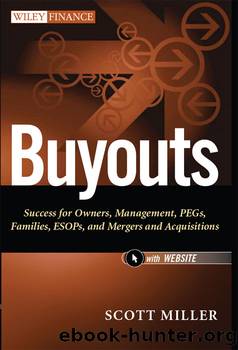Buyouts by Scott D. Miller

Author:Scott D. Miller [Miller, Scott D.]
Language: eng
Format: epub
ISBN: 9781118282748
Published: 2012-07-05T16:00:00+00:00
Selling Stock to the Employee Stock Ownership Plan and Trust
Employing the use of an ESOP as part of the buyout strategy means that the exchange is contemplated only as a stock-based transaction. An ESOP may only purchase the stock of a selling shareholder, and by default managers and key employees will also be acquiring stock.
Typically, a stock-based transaction is highly favored by the seller because it means the sale is likely a capital gain taxable event. With ESOPs the gain on the sale of stock is a function of the company being an S corporation or a C corporation (only corporations may have an ESOP). As an S corporation, the gain on the sale subject to the applicable holding period is taxable to the selling shareholders as capital gain. As a C corporation, the gain on the sale subject to applicable holding periods may be taxable as either capital gain or there is a special election available only to individual shareholders in a C corporation to have the gain fully deferred (âtax freeâ) under IRC Section 1042. The IRC Section 1042 election will be illustrated later in the chapter, but it essentially enables the selling shareholder to defer all taxes on the sale of stock to the C corporation ESOP once qualifying regulations are satisfied. The key regulations include selling at least 30% of the value of the corporation to the ESOP, and investing the sale proceeds into qualified replacement property (QRP) within one year of the transaction date. Compliance issues are strict if the IRC Section 1042 election is made.
Purchase of Stock with Pre-Tax or After-Tax Dollars
Management has the opportunity to acquire a direct equity stake in the business, but as previously indicated this equity stake must be acquired with after-tax dollars. Even if the company assists management with loans or extended terms, the stock will still be acquired with after-tax dollars. Management, having acquired its stake in a hard-earned manner, may appreciate the ownership interest and work harder to insure the investment grows. Management enjoys the appreciation of the investment until such time as the employment in the company ends, and the investment is redeemed or sold to a successor owner. In many cases management also serves as the directors, key officers of the business, and as trustees of the ESOP. Management typically serves in many corporate governance roles, and while it is common in many privately held companies, this is not recommended. Conflicts of interest may arise with the duties and obligations of the various positions and the same individual serving in conflicted roles is placed in a potentially litigious situation.
While managers and investors acquire an equity interest with after-tax dollars, the ESOP is distinctive in its ability to acquire the same equity interest with tax-deductible dollars. The advantage of this attribute will be illustrated in our examples. The clear advantage of this tax benefit is easy to see if the effective income tax rate is 40%. The outside investor must produce $100 in after-tax dollars to acquire stock in the company.
Download
This site does not store any files on its server. We only index and link to content provided by other sites. Please contact the content providers to delete copyright contents if any and email us, we'll remove relevant links or contents immediately.
The Data Detective by Tim Harford(1101)
100 Tricks to Appear Smart in Meetings by Sarah Cooper(798)
Mind Management, Not Time Management by David Kadavy(763)
GMAT For Dummies 2021 by Lisa Zimmer Hatch & Scott A. Hatch(698)
Amazing Decisions by Dan Ariely(643)
99 Financial Terms Every Beginner, Entrepreneur & Business Should Know (Financial IQ Series Book 1) by Herold Thomas(607)
The Smart Strategy Book by Kevin Duncan(536)
The Data Science Framework by Unknown(508)
The Store Detective Training Manual: A Practical Reference for Current and Aspiring Loss Prevention Officers by Glen Canarte(449)
Poor Students, Rich Teaching by Eric Jensen(432)
Cambridge IGCSE and O Level Business Studies by Karen Borrington(417)
Robert's Rules of Order by Henry M. Robert(414)
Arts, Sciences, and Economics by Tönu Puu(412)
Enterprise Analytics by Thomas H. Davenport(406)
Sustainable Education and Development by Unknown(396)
97 Things Every Information Security Professional Should Know by Christina Morillo(394)
Side Hustles: How to Make Extra Money Online by Hayden Vernon(384)
Excel 2016 for Marketing Statistics by Thomas J. Quirk & Eric Rhiney(373)
Information Literacy in Higher Education by unknow(352)
